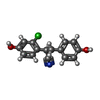[English] 日本語
 Yorodumi
Yorodumi- PDB-7xwq: Human Estrogen Receptor beta Ligand-binding Domain in Complex wit... -
+ Open data
Open data
- Basic information
Basic information
| Entry | Database: PDB / ID: 7xwq | ||||||
|---|---|---|---|---|---|---|---|
| Title | Human Estrogen Receptor beta Ligand-binding Domain in Complex with (R)-2-(2-chloro-4-hydroxyphenyl)-3-(4-hydroxyphenyl)propanenitrile | ||||||
 Components Components |
| ||||||
 Keywords Keywords | TRANSCRIPTION/INHIBITOR / Inhibitor / TRANSCRIPTION / TRANSCRIPTION-INHIBITOR complex | ||||||
| Function / homology |  Function and homology information Function and homology informationreceptor antagonist activity / nuclear estrogen receptor activity / nuclear steroid receptor activity / estrogen response element binding / positive regulation of DNA-binding transcription factor activity / estrogen receptor signaling pathway / steroid binding / ESR-mediated signaling / cellular response to estradiol stimulus / negative regulation of cell growth ...receptor antagonist activity / nuclear estrogen receptor activity / nuclear steroid receptor activity / estrogen response element binding / positive regulation of DNA-binding transcription factor activity / estrogen receptor signaling pathway / steroid binding / ESR-mediated signaling / cellular response to estradiol stimulus / negative regulation of cell growth / Nuclear Receptor transcription pathway / nuclear receptor activity / Constitutive Signaling by Aberrant PI3K in Cancer / cell-cell signaling / PIP3 activates AKT signaling / PI5P, PP2A and IER3 Regulate PI3K/AKT Signaling / DNA-binding transcription factor activity, RNA polymerase II-specific / Extra-nuclear estrogen signaling / RNA polymerase II cis-regulatory region sequence-specific DNA binding / intracellular membrane-bounded organelle / regulation of DNA-templated transcription / regulation of transcription by RNA polymerase II / chromatin / positive regulation of DNA-templated transcription / enzyme binding / negative regulation of transcription by RNA polymerase II / signal transduction / positive regulation of transcription by RNA polymerase II / mitochondrion / DNA binding / zinc ion binding / nucleoplasm / nucleus Similarity search - Function | ||||||
| Biological species |  Homo sapiens (human) Homo sapiens (human) | ||||||
| Method |  X-RAY DIFFRACTION / X-RAY DIFFRACTION /  SYNCHROTRON / SYNCHROTRON /  MOLECULAR REPLACEMENT / Resolution: 1.89 Å MOLECULAR REPLACEMENT / Resolution: 1.89 Å | ||||||
 Authors Authors | Furuya, N. / Handa, C. | ||||||
| Funding support | 1items
| ||||||
 Citation Citation |  Journal: J.Steroid Biochem.Mol.Biol. / Year: 2022 Journal: J.Steroid Biochem.Mol.Biol. / Year: 2022Title: Evaluating the correlation of binding affinities between isothermal titration calorimetry and fragment molecular orbital method of estrogen receptor beta with diarylpropionitrile (DPN) or DPN derivatives. Authors: Handa, C. / Yamazaki, Y. / Yonekubo, S. / Furuya, N. / Momose, T. / Ozawa, T. / Furuishi, T. / Fukuzawa, K. / Yonemochi, E. | ||||||
| History |
|
- Structure visualization
Structure visualization
| Structure viewer | Molecule:  Molmil Molmil Jmol/JSmol Jmol/JSmol |
|---|
- Downloads & links
Downloads & links
- Download
Download
| PDBx/mmCIF format |  7xwq.cif.gz 7xwq.cif.gz | 106.4 KB | Display |  PDBx/mmCIF format PDBx/mmCIF format |
|---|---|---|---|---|
| PDB format |  pdb7xwq.ent.gz pdb7xwq.ent.gz | 78.5 KB | Display |  PDB format PDB format |
| PDBx/mmJSON format |  7xwq.json.gz 7xwq.json.gz | Tree view |  PDBx/mmJSON format PDBx/mmJSON format | |
| Others |  Other downloads Other downloads |
-Validation report
| Summary document |  7xwq_validation.pdf.gz 7xwq_validation.pdf.gz | 957.7 KB | Display |  wwPDB validaton report wwPDB validaton report |
|---|---|---|---|---|
| Full document |  7xwq_full_validation.pdf.gz 7xwq_full_validation.pdf.gz | 958 KB | Display | |
| Data in XML |  7xwq_validation.xml.gz 7xwq_validation.xml.gz | 17.9 KB | Display | |
| Data in CIF |  7xwq_validation.cif.gz 7xwq_validation.cif.gz | 25.1 KB | Display | |
| Arichive directory |  https://data.pdbj.org/pub/pdb/validation_reports/xw/7xwq https://data.pdbj.org/pub/pdb/validation_reports/xw/7xwq ftp://data.pdbj.org/pub/pdb/validation_reports/xw/7xwq ftp://data.pdbj.org/pub/pdb/validation_reports/xw/7xwq | HTTPS FTP |
-Related structure data
| Related structure data |  7xvyC 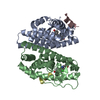 7xvzC 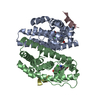 7xwpC 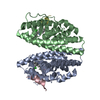 7xwrC 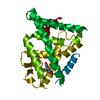 2giuS S: Starting model for refinement C: citing same article ( |
|---|---|
| Similar structure data | Similarity search - Function & homology  F&H Search F&H Search |
- Links
Links
- Assembly
Assembly
| Deposited unit | 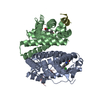
| ||||||||
|---|---|---|---|---|---|---|---|---|---|
| 1 |
| ||||||||
| Unit cell |
|
- Components
Components
| #1: Protein | Mass: 27702.578 Da / Num. of mol.: 2 / Fragment: ligand-binding domain / Mutation: C334S,C369S,C481S Source method: isolated from a genetically manipulated source Source: (gene. exp.)  Homo sapiens (human) / Gene: ESR2, ESTRB, NR3A2 / Plasmid: pGEX6P1 / Production host: Homo sapiens (human) / Gene: ESR2, ESTRB, NR3A2 / Plasmid: pGEX6P1 / Production host:  #2: Protein/peptide | Mass: 1386.594 Da / Num. of mol.: 2 / Source method: obtained synthetically / Source: (synth.)  Homo sapiens (human) Homo sapiens (human)#3: Chemical | #4: Water | ChemComp-HOH / | Has ligand of interest | Y | |
|---|
-Experimental details
-Experiment
| Experiment | Method:  X-RAY DIFFRACTION / Number of used crystals: 1 X-RAY DIFFRACTION / Number of used crystals: 1 |
|---|
- Sample preparation
Sample preparation
| Crystal | Density Matthews: 2.01 Å3/Da / Density % sol: 38.78 % |
|---|---|
| Crystal grow | Temperature: 293 K / Method: vapor diffusion, sitting drop / pH: 6.5 Details: 16-20% PEG3350, 100 mM BisTris pH6.5, 200 mM Magnesium Acetate |
-Data collection
| Diffraction | Mean temperature: 100 K / Serial crystal experiment: N |
|---|---|
| Diffraction source | Source:  SYNCHROTRON / Site: SYNCHROTRON / Site:  Photon Factory Photon Factory  / Beamline: BL-17A / Wavelength: 1 Å / Beamline: BL-17A / Wavelength: 1 Å |
| Detector | Type: DECTRIS EIGER X 16M / Detector: PIXEL / Date: Mar 20, 2019 |
| Radiation | Protocol: SINGLE WAVELENGTH / Monochromatic (M) / Laue (L): M / Scattering type: x-ray |
| Radiation wavelength | Wavelength: 1 Å / Relative weight: 1 |
| Reflection | Resolution: 1.89→46.24 Å / Num. obs: 35187 / % possible obs: 92 % / Redundancy: 5.7 % / CC1/2: 0.999 / Net I/σ(I): 28.9 |
| Reflection shell | Resolution: 1.89→1.93 Å / Num. unique obs: 819 / CC1/2: 0.558 |
- Processing
Processing
| Software |
| |||||||||||||||||||||||||||||||||||||||||||||||||||||||||||||||||||||||||||
|---|---|---|---|---|---|---|---|---|---|---|---|---|---|---|---|---|---|---|---|---|---|---|---|---|---|---|---|---|---|---|---|---|---|---|---|---|---|---|---|---|---|---|---|---|---|---|---|---|---|---|---|---|---|---|---|---|---|---|---|---|---|---|---|---|---|---|---|---|---|---|---|---|---|---|---|---|
| Refinement | Method to determine structure:  MOLECULAR REPLACEMENT MOLECULAR REPLACEMENTStarting model: 2giu Resolution: 1.89→46.24 Å / Cor.coef. Fo:Fc: 0.947 / Cor.coef. Fo:Fc free: 0.93 / Cross valid method: THROUGHOUT / σ(F): 0 / ESU R: 0.173 / ESU R Free: 0.157 / Stereochemistry target values: MAXIMUM LIKELIHOOD Details: HYDROGENS HAVE BEEN ADDED IN THE RIDING POSITIONS U VALUES : REFINED INDIVIDUALLY
| |||||||||||||||||||||||||||||||||||||||||||||||||||||||||||||||||||||||||||
| Solvent computation | Ion probe radii: 0.8 Å / Shrinkage radii: 0.8 Å / VDW probe radii: 1.2 Å / Solvent model: MASK | |||||||||||||||||||||||||||||||||||||||||||||||||||||||||||||||||||||||||||
| Displacement parameters | Biso max: 73.58 Å2 / Biso mean: 22.567 Å2 / Biso min: 11.51 Å2
| |||||||||||||||||||||||||||||||||||||||||||||||||||||||||||||||||||||||||||
| Refinement step | Cycle: final / Resolution: 1.89→46.24 Å
| |||||||||||||||||||||||||||||||||||||||||||||||||||||||||||||||||||||||||||
| Refine LS restraints |
| |||||||||||||||||||||||||||||||||||||||||||||||||||||||||||||||||||||||||||
| LS refinement shell | Resolution: 1.891→1.94 Å / Total num. of bins used: 20
|
 Movie
Movie Controller
Controller


 PDBj
PDBj
